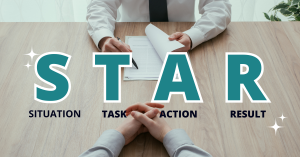Why GoGecko Recommends the Star Technique for Interviews
When employers interview you, they don’t just want to know about your skills and your personality – they want to know you have proven experience too. This involves testing whether you can do things like problem solve, bring fresh ideas to the table, or deal with difficult customers, and it means putting you on the spot. Scary, huh? It doesn’t have to be if you use the STAR technique for interviews, something we actively champion at GoGecko.
This technique involves using STAR as an acronym to logically put together your response to a question that starts with the dreaded ‘give me an example of when you -‘. It’s so easy to go to pieces when you’re asked to recall a particular example of your skills. Struggling to construct a confident answer that has a strong point is a likely outcome if you don’t prepare. This technique gives you a simple structure to help prepare competency based examples for interview, covering letters and CVs. It works like this…
 S – Situation. Set the scene, provide the context. So, if you’re asked about a time you dealt with an unhappy client, explain the situation or project through which the problem occurred, and briefly explain why it happened. This will back up your following points.
S – Situation. Set the scene, provide the context. So, if you’re asked about a time you dealt with an unhappy client, explain the situation or project through which the problem occurred, and briefly explain why it happened. This will back up your following points.
T – Task. What was your role in this instance? It may have been a team effort, but the interviewer wants to know the difference you made, so be specific on the capacity in which you took action. Maybe you were the employee that had to directly deal with the difficult customer, or maybe you were the manager that authorised the employee to offer a refund. Make your role clear.
A – Action. So, what did you do to make sure this unhappy person didn’t storm out, steam billowing from their ears, to tell anyone that would listen how dissatisfied they were you’re your product or service? Maybe you used your calm, collected attitude to apologise profusely, explain what had gone wrong to the customer, and offer them a full refund and money off their next visit. This is an example of your ability to handle conflict, solve the problem effectively, and your excellent grasp of good customer service.
R – Result. Perhaps it goes without saying, but we’ll say it anyway – pick an instance in which the outcome was good. Interviewers want to know how effective your working practices are, so make sure the end result is smiles all round. Many people are good at explaining the general situation and task, but often forget the result to the business, which is key to demonstrating your relevant value to any prospective employer. You need to tell a story, and all stories have a satisfying end.
Of course, this technique is made so much more effective by creating a good mental file of answers in advance, covering examples of teamwork, customer service, communication, organisation, decision making, positive risk taking, and new ideas. These are the topics that so many competency questions are based around, and having some examples ready to be crafted into the perfect, concise STAR answer could be what differentiates you from other candidates.
Interviews should flow, so practising plenty of answers for all eventualities will help you shine. Above all, be yourself, but preparation makes you the best version of yourself, and that’s what you’ll always want prospective employers to see! For further advice regarding the STAR technique, feel free to contact us.





